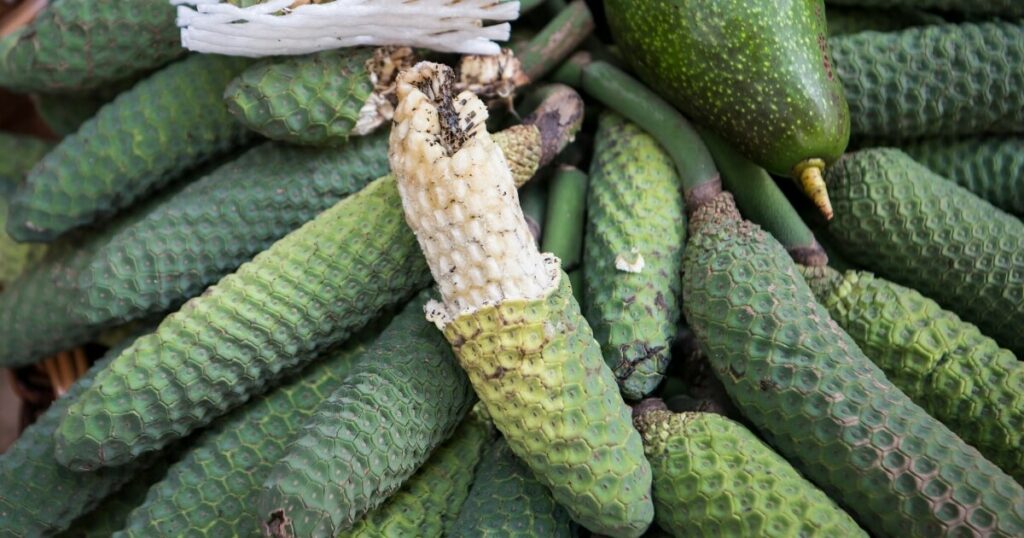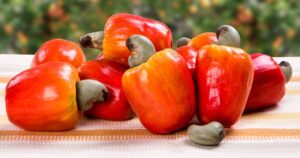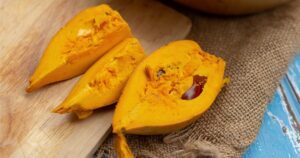Monstera Deliciosa, also called the Swiss cheese plant, is a tropical fruit that’s taste compares to a mix of banana and pineapple. This flavor combo feels both exotic and familiar.
It’s a sweet and tangy profile that’s hard to compare. It’s like a fruit salad all in one bite.
This fruit isn’t your everyday apple or orange. It’s a conversation starter, a centerpiece, and a culinary journey all rolled into one. So, if you’re ready to learn more about this fascinating fruit, let’s get started.
How Do Monstera Fruits Taste?
Imagine the sweetness of a ripe banana, the tanginess of a pineapple, and the lushness of a ripe mango all rolled into one. That’s the taste of Monstera for you.

The texture of Monstera fruit is another aspect that sets it apart. It’s soft and creamy, much like a ripe banana, but with a slight crunch like pineapple. This combination of taste and texture makes Monstera a fruit like no other.
But remember, the key to enjoying Monstera fruit is to consume it when it’s fully ripe. An unripe Monstera can leave a bitter taste and cause discomfort. So, patience is key when it comes to enjoying this tropical delight.
Types Of Monstera
There are several types of Monstera, but the most common one that bears edible fruit is Monstera Deliciosa. Here’s how they compare:
- Monstera Deliciosa: The fruit of this variety is sweet and tropical, with a flavor reminiscent of banana, pineapple, and mango.
- Monstera Adansonii: This variety is more commonly grown for its ornamental leaves and doesn’t typically bear fruit in home conditions.
- Monstera Borsigiana: Similar to Adansonii, Borsigiana is usually grown as a houseplant and doesn’t often produce fruit.
Comparing Monstera With Other Fruits
Monstera fruit can be compared to a few other fruits:
- Banana: Monstera fruit has a sweetness that’s similar to a ripe banana but with a more tropical twist.
- Pineapple: The tanginess of Monstera fruit is reminiscent of pineapple, but it’s not as acidic.
- Mango: There’s a richness to Monstera fruit that’s similar to a ripe mango, but it’s not as fibrous.
Do Monstera Fruits Taste Good?
Monstera fruits are a delight for those who love tropical flavors. However, the taste might not appeal to everyone, especially if you do not like sweet and tangy fruits.
The taste of Monstera fruit also depends on its ripeness. A perfectly ripe Monstera fruit is sweet and juicy, while an unripe one can be harsh and unpleasant. So, knowing when the fruit is ripe and ready to eat is crucial.
Freezing Monstera fruit can help preserve its flavor and make it last longer. However, it might slightly alter the texture, making it less juicy and more firm. But the tropical flavor remains, making it a great addition to smoothies or fruit salads.
What Does Monstera Fruit Look Like?
Monstera fruit is quite distinctive in appearance. It’s elongated and covered with green scales, resembling a green corn cob or a pinecone. The fruit can grow up to a foot long, making it quite a sight!

When buying Monstera fruit at the grocery store, look for one that’s firm with tight scales. The fruit should be heavy for its size, indicating that it’s juicy and ripe. Avoid fruits with loose scales or those that have a fermented smell, as these are signs of over-ripeness.
Remember, Monstera fruit needs to ripen after it’s picked, similar to an avocado. So, don’t worry if the fruit you buy is still green and unripe. Just let it sit at room temperature for a few days until the scales start to lift, indicating that it’s ripe and ready to eat.
Do Monstera Fruits Have Seeds?
Yes, Monstera fruits do contain seeds. They’re similar to seeds found in a pineapple or papaya. The seeds are small and black, and they’re perfectly safe to eat.
However, the seeds are not the main attraction of Monstera fruit. It’s the sweet, tropical flesh that’s the real star. So, while you can eat the seeds if you wish, most people choose to discard them and focus on the fruit instead.
How To Make Monstera Fruits Taste Good
While Monstera fruits are delicious on their own, you can enhance their flavor in a few ways. Here are some tips:
- Let it ripen: Monstera fruit tastes best when it’s fully ripe. Let the fruit sit at room temperature until the scales start to lift, indicating that it’s ripe and ready to eat.
- Chill it: Like many fruits, Monstera fruit tastes even better when it’s chilled. After ripening, store the fruit in the refrigerator for a few hours before eating.
- Pair it with other fruits: While Monstera fruit is not to be added to recipes in this context, it pairs well with other fruits. Try eating it with a side of berries or a squeeze of lime for an extra burst of flavor.
- Avoid unripe parts: Monstera fruit’s unripe parts can irritate the mouth and throat. Make sure to only eat the parts of the fruit that have fully ripened to avoid discomfort.
- Clean it well: Before eating, make sure to clean the fruit well to remove any dirt or debris. This will ensure that you’re getting the pure, unadulterated taste of the fruit.
How To Use Monstera Fruits In Recipes And Side Dishes
Here are some popular ways to use Monstera fruits:
Recipes
- Monstera Fruit Salad: Toss chunks of ripe Monstera fruit with other tropical fruits like mango, pineapple, and kiwi. Drizzle with a little honey or agave syrup if you like it sweeter. Remember, the flavors should complement each other, not compete.
- Monstera Smoothie: Blend ripe Monstera fruit with a banana and a splash of coconut milk for a tropical smoothie. Add a handful of spinach for an extra nutrient boost without affecting the taste.
- Monstera Sorbet: Puree ripe Monstera fruit, add a bit of sugar and lemon juice, then freeze. Stir every hour until it’s firm and scoopable. It’s a refreshing dessert on a hot day.
Side Dishes
- Monstera Fruit Salsa: Dice ripe Monstera fruit and mix it with diced tomatoes, onions, cilantro, and a squeeze of lime. It’s a tropical twist on traditional salsa, perfect for grilled fish or chicken.
- Monstera Fruit Slaw: Shred some cabbage and carrot, then add diced Monstera fruit. Toss with a light vinaigrette for a tangy, sweet slaw that’s great with barbecued meats.
- Monstera Fruit Chutney: Simmer diced Monstera fruit with sugar, vinegar, ginger, and spices until thickened. It’s a sweet and tangy condiment that pairs well with roasted meats.
Remember, when using Monstera fruit in recipes, make sure it’s fully ripe to avoid any potential irritation from the unripe parts.
Monstera Fruit FAQs
How Do You Know When a Monstera Fruit is Ripe?
A Monstera fruit is ripe when its green scales start to lift and peel off on their own. It’s important to wait until the fruit ripens naturally, as eating it too early can irritate the mouth and throat.
Can You Eat Monstera Fruit Raw?
Yes, you can eat Monstera fruit raw. It’s usually enjoyed fresh, much like other tropical fruits. Just make sure it’s fully ripe before you dig in to enjoy its unique blend of flavors.
Is Monstera Fruit Available Year-Round?
Monstera fruit is tropical, so its availability may depend on your location. In regions where it’s grown, it can be found year-round. However, in other areas, it might be more seasonal or available in specialty stores.
My Tasty Thoughts
Monstera fruit is not as commonly available as other fruits, so you might need to look for it in specialty stores or farmers’ markets.
Also, remember that Monstera fruit needs to ripen after it’s picked. So, if you buy one that’s still green, you’ll need to wait a few days until it’s ripe and ready to eat. But once you’ve tasted its sweet, tropical flavor, you’ll see that it’s worth the wait!


